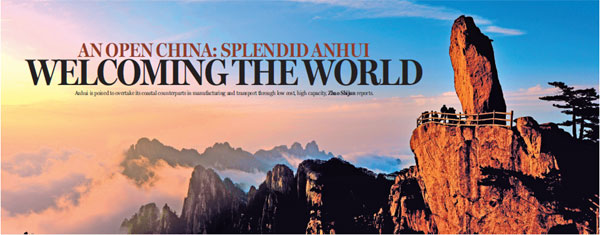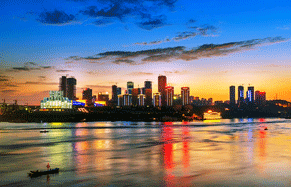An open china: splendid anhui welcoming the world
Anhui is poised to overtake its coastal counterparts in manufacturing and transport through low cost, high capacity, Zhao Shijun reports.
An international promotional fair for Anhui is being held today in Beijing, aiming to make the East China province's recent development, business opportunities and glorious culture better known to the world. The event, organized by the Chinese Ministry of Foreign Affairs, has attracted the attention of foreign diplomats in China, representatives for international organizations and multinational companies as well as international media. Anhui's authorities expect to use the event to showcase Anhui's business environment to international investors, attractions for foreign tourists and the province's determination to integrate into the global economy.
Anhui is on its way to becoming a new frontier in China's inland regions' opening-up, according to Li Jinbin, Party chief of Anhui province.
He said Anhui is an important part of several key national development strategies, including the Belt and Road Initiative and the Yangtze River Delta Economic Zone.
When visiting Anhui in April last year, Chinese President Xi Jinping also encouraged Anhui to blaze a new trail for the development of central China, based on its own advantages and driven by reforms and innovations.
The province is at the crossroads linking China's eastern, central and western regions through a comprehensive transportation system consisting of waterways, highways, railways and airports.
Anhui is on the lower reaches of the Yangtze River - the "golden waterway of China". Thanks to its large number of ports on the river, the province is linked to the world through shipping routes to the Pacific in the east, as well as China's central and western regions along the 21st Century Maritime Silk Road and Silk Road Economic Belt.
The province is also between the Beijing-Tianjin-Hebei Economic Zone in the north and the Pearl River Delta Economic Zone in the south.
"Anhui plans to become a pivotal region for the Belt and Road Initiative," said Zhang Shaochun, head of the provincial development and reform commission.
He said Anhui has launched a total of 106 projects for investment and trade cooperation with countries along the trade routes since the Belt and Road Initiative began in 2013. The combined value of such projects amounted to 962.4 billion yuan ($140 billion). More than half of the projects are under construction or already operational.
Last year alone, 13 multinational companies from Belt and Road countries established operations in Anhui. Their investment totaled $760 million.
In the same period, companies in Anhui set up 27 enterprises in countries along the routes, with total investment of $73.27 million.
The Sino-German Educational Cooperation Demonstration Base - a joint education and research program between Anhui's Hefei University and Germany's Stralsund University of Applied Science - began operations last year, according to Cai Jingmin, Party chief of Hefei University.
A Sino-German smart manufacturing industrial park also broke ground in Hefei, aiming to integrate the two nations' industrial strategies - Made in China 2025 and German Industry 4.0.
German automaker Volkswagen signed an agreement with Anhui's local automaker JAC Motors in September last year for the opening of Volkswagen's third joint venture in China. The venture will mainly produce electric vehicles.
In addition to the Sino-German facilities, Anhui has launched a number of programs to enhance cooperation with Belt and Road regions and beyond.
These programs include the Hefei-Xinjiang-Europe freight train line initiated in 2015, the Guangzhou-Hefei-Los Angeles cargo flight launched in 2016, the Hefei Cross-Border E-Commerce Pilot Zone established in 2016 and the Hefei Airport Bonded Logistics Center set up in 2016. These facilities are expected to boost foreign investment and international trade for Anhui.
Anhui's fruitful cooperation with these regions has caused a rise in the province's inbound investment and international trade.
According to the Anhui Bureau of Commerce, a total of 121 foreign-funded projects were approved in Anhui last year. The actual foreign investment value in Anhui in 2016 was $1.24 billion, growing 28 percent from 2015 and setting a new record for growth.
New opportunities
The province's recent economic development has presented new opportunities for international investors, said Li Guoying, governor of Anhui.
He said Anhui is adjacent to Chinese economic powerhouses like Shanghai, Zhejiang and Jiangsu, which are all in the Yangtze River Delta region. Regional cooperation has been flourishing due to the complementary nature of these economies.
Shanghai, Zhejiang and Jiangsu are currently moving their manufacturing industries inland due to limited available space and higher operational costs closer to the coast.
Capitalizing on its solid industrial foundation and its strength in higher education and high-tech research, Li said Anhui is in a good position to overtake advanced manufacturing and high-tech industries from Shanghai and Jiangsu.
One location poised to witness and support the industrial shift is the Wanjiang City Belt, a region in south-central Anhui that includes the province's major cities like Hefei, Wuhu, Ma'anshan, Anqing, Chuzhou, Chizhou, Tongling, Xuancheng and Lu'an
The city belt runs roughly parallel to the Yangtze golden waterway, ensuring that products in Anhui can be effectively transported to the vast hinterland of central and western China and to overseas markets.
"We are planning to develop a comprehensive, air-land-river-ocean shipment channel to ease logistics and trade," said Zhang Xiaozhong, an official at the Anhui Development and Reform Commission, who is responsible for the city belt's development.
According to Zhang, improvements to the Yangtze waterway and ports along the river are underway to accommodate larger ships. Several new highways and railways linking Anhui to the rest of the country are either operational or under construction.
He also mentioned that the recently built airports in Hefei and Jiuhuashan and nearly a dozen new cross-Yangtze traffic channels can play bigger roles in expanding Anhui's transport capacity.
According to the provincial development and reform commission, Anhui hopes to enhance its electronic information, advanced manufacturing, automobile, bio-medicine, new energy and new materials industries through attracting investment, technology and high-end professionals from home and abroad.
Contact the writer through zhaoshijun@chinadaily.com.cn



(China Daily 04/11/2017 page25)















